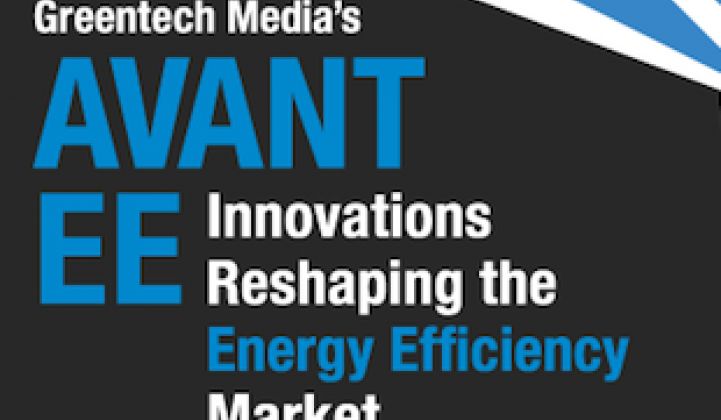It's lunchtime in San Francisco, and the 250 attendees at GTM's energy efficiency event Avant EE are dining at PG&E headquarters after a morning packed full of talks and events featuring industry experts who are charting the course of intelligent energy efficiency.
Setting the stage
PG&E's Jan Berman kicked off the event with an overview of PG&E's 30-year efficiency commitment. She noted that the flat per-capita growth of electricity in California (the Rosenfeld curve) has avoided the construction of 30 natural gas-burning power plants.
GTM's energy efficiency editor, Stephen Lacey, introduced the concept of intelligent efficiency -- that is, distilling the deluge of energy data into actionable and effective energy efficiency measures.
Lacey quoted Jeremy Rifkin in his assessment of energy efficiency: "When energy revolutions occur, they require communication revolutions that are agile enough to manage them."
Part of the energy efficiency "revolution" is awareness. Greg Dixon of EnerNOC has noted that "the vast majority of companies [EnerNOC] works with in the C&I space don't even know how much they spend on energy."
The positive side is, in Lacey's words, that "lack of awareness is an opportunity for energy savings." He added, "The interchange of information is creating a new paradigm for the energy efficiency market."
Unlocking capital for energy efficiency projects
Brad Copithorne, Director of Clean Energy Financing Solutions at the Environmental Defense Fund, has been a long-time advocate for on-bill financing and is driving this mechanism in the California energy rule-making process. This policy change would allow consumers to borrow money for energy efficiency improvements and repay the loan on their utility bill, a bill that most people prioritize as they wish to continue to experience luxuries like hot water and cold beer. The legislation would allow small businesses to borrow up to $100,000 and repay that on their utility bill. The financing is engineered so as to survive a foreclosure.
Currently, the money would come from PG&E, but Copithorne notes that PG&E shouldn't be in the banking business any more than Goldman Sachs, Deutsche Bank, or Barclays should be in the energy delivery business.
The California program is due to begin early next year, if it can weather any potential political storm.
Alan Gordon, Deputy Controller, Environmental Policy, California State Controller's Office, called energy efficiency "the holy grail" but observed that "the primary impediment from a policy level is scale." He said that Goldman Sachs and Deutsche Bank have $3 trillion in assets they would like to put to work in California but "their opening [increment] is $50 million or $100 million." The energy efficiency industry has to learn how to aggregate and securitize its debt in chunks of those sizes.
Securitization is the practice of pooling disparate sources of debt and selling it as a package to investors on the secondary market.
Gordon noted that the point of the securitization exercise is that it allows the debt to be sold into the bond market, making the money cheaper for the market and the consumer. For that to actually occur, Gordon said property owners and lenders need a common language and there needs to be a state-level certification of energy efficiency contractors.
Gordon noted that the current legislation has "32 supporters across the board...and no opposition." He said that the policy is worked out and "now we have to work the political side." He noted that Maryland, New Jersey, Colorado, New England, and New York will follow California's lead.
All the panelists and many of this event's attendees agree that securitization is coming -- but no one is willing to say whether it will be in one or ten years.
As Stephen Lacey wrote, the industry consensus seems to be that it is necessary to craft better policy to stimulate a greater volume of projects and encourage financial innovation.
"We've been stuck with poor policies. But policy helps create demand for new financial instruments. If you create that wheel, there's big opportunities for lots of players," said Lamb.
Some case studies
Mary Curtiss, the National Director of Energy & Sustainability Services at Jones Lang LaSalle, works on "Integrated Energy Retrofits (IERs)." She furnished a few case studies pertaining to flagship building projects. Based on her experience, she insisted that the best way to improve the energy efficiency of a building is a holistic approach, looking at the whole system and the entire building.
Those flagship properties include San Francisco's Moscone Center, New York's Empire State Building, and Chicago's Union Station. We'll provide more details on these projects in the coming days, but the common thread in looking at these projects is smart planning, holistic thinking, a sustainability master plan, the creation of an amenable organizational culture, and emphasis on bringing all stakeholders into the conversation.
She notes that Integrated Energy Retrofits work. The Empire State Building reduced energy by 38 percent and saved millions of dollars.
Curtiss asked, "Your buildings are talking: are you listening?"
***
To watch additional videos from Avant EE, visit our Ustream channel. Greentech Media remains your source for thought leadership on energy efficiency.



